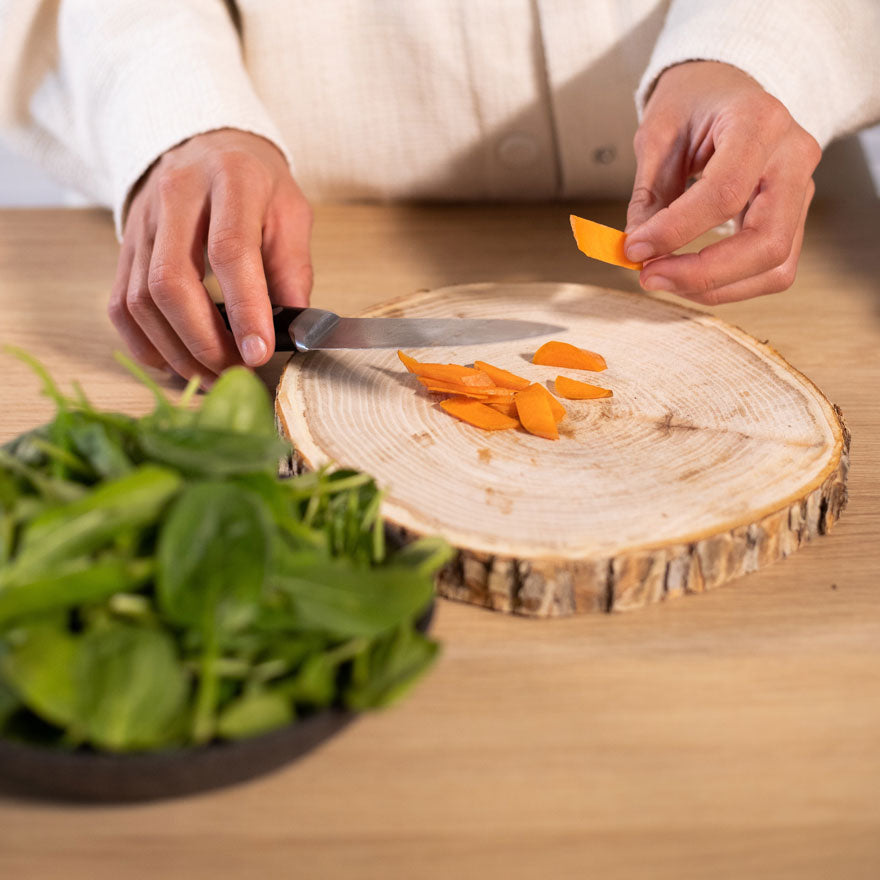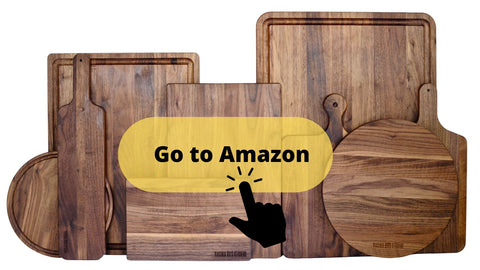Butchers Block Cutting Board: DIY vs Premade
Brian Lejeune
Butchers Block Cutting Board: DIY vs Premade
If you’re an avid fan of cooking shows (*cough* MasterChef *cough*) like we are, you may already know why butcher block cutting boards are necessary for kitchens. For those who are new to this, let’s take a look into it.
Using a premade or DIY butcher’s block with your knife is as imperative as using paper with a pencil.
Sure, you can write on your walls if you like, but should you?
If your answer is no, then you’re exactly right. Your wall would be a mess, and your pencil destroyed from running over the uneven surface.
The case is the same for knives. Knife edges are sharp but delicate structures that can be blunted by coarse surfaces. Since knives are one of the most important tools in cooking, we wouldn’t want them to wear down easily.
So, let’s introduce you to your knife's closest colleagues, butcher block cutting boards.
The boards are soft on knives, saving them from unnecessary damage from continued use.
Boards are primarily used as a surface for cutting and chopping foods ranging from vegetables to meat. They have a sturdy base which makes them heavy and less prone to slipping while in use.
Depending on their use, you can pair your knife with a premade or DIY butcher block to get the most out of them.
Why Butcher Block Cutting Boards Are a Good Choice
Premade and DIY butcher blocks provide a softer surface for the knife to work on, helping the knife stay sharp.
However, did you know a butcher block cutting board isn’t the only surface used to cut food?
You may also have seen cooks use a steel or wooden countertop in professional kitchens. However, you don’t want a countertop with scratches accumulating over time.
We suggest you go for a premade butcher’s block instead of a countertop. That, however, raises another question.
Should you make your own DIY butcher blocks or just buy a premade one?
Differences Between DIY and Premade Boards
If you’re still concerned about choosing between a DIY board or a premade one, we’ve got you covered.
We’ve listed some of their differences:
| Premade | DIY |
| Craftsmen MUST be experienced | DIY does not require such expertise; just the technical know-how |
| The wood and grain are chosen with the board’s purpose in mind | Choosing the wrong wood or grain is highly possible. |
| Seamless joints between the pieces and great finish | Joining without proper expertise will leave you with a wonky board |
| The boards do not splinter | DIY boards may splinter during production if proper woodworking procedures are not followed |
| The wood is cured with industrial-grade tools and left with a beautiful edge grain. | Curing wood at home takes from a few weeks to a whole year, even with the use of a dehumidifier |
|
The wood is guaranteed to last for years with proper oil treatment (Pro-tip: Avoid standard mineral oil) |
DIY boards don’t have a professional guarantee since they’re home-made |
| Accurate board measurements due to the use of professional tools and machinery | Measurements can be off compared to premade boards |
What Defines A Butcher Block Cutting Board?
Now that we’ve established the differences between DIY and premade boards, we can move on to discussing the board itself.
To qualify as a cutting board, the following requirements need to be met:
- The board should be made of end grain.
- It should range from 0.75-1.5 inches in thickness.
- It should be large enough for all kinds of meal prep
These features are in place for a durable wooden board, but you can still go ahead and use a thinner DIY board or even a plastic one to chop your meat.
However, chopping meat is rough work, so it's bound to leave cracks on thinner wood and DIY cutting boards over time.
This is why it’s always best to use sturdier options made of end-grain that can absorb this kind of damage.
The reason behind it is simple, the fibers of the end grain seal themselves over time.
Another aspect to consider is the inclusion of juice grooves. When raw food is cut, it secretes juices that fall over the sides while cutting them. Grooves help collect those juices and keep your workstation clean.

20 x 15 Extra Large End Grain Walnut Wood Cutting Board - ChessMaster Pattern
Why You Shouldn't Use a DIY Cutting Board
Yes, DIY butcher blocks can easily handle being used as wood cutting boards but using a premade board means less stress. The premade board also lasts longer in butchering tougher meat than a DIY butcher's block.
In short, using a DIY butcher’s block in place of premade wood cutting boards isn’t recommended, and there are even more reasons why.
First off, always use different boards for different foods. You don’t want your veggies to smell like fish, do you? Chances are if you have a DIY board, you won’t have as many interchangeable options as you would with a premade one.
Cross-contamination can lead to food poisoning, too. When raw meat is cut, its juice can seep into the surface layer of the board, transferring its bacteria to other meats or vegetables. It’s highly recommended you have a different premade board for each job, and properly sanitize your board after each use.
Further, DIY butcher blocks are harder to lift and work with than premade butcher blocks due to their increased likelihood of splintering.
It can be a hassle since you’ll need to move the butcher block around every time you use it. If the board is splintering, you can easily injure yourself. Professionally made wood cutting boards are studier, won’t sprinter, and therefore, are a far better choice.
Why You Should Go With Premade Boards
Everything we discussed just shows the amount of knowledge and effort that goes into selecting and using the right board.
Manufacturing DIY boards are a different story; it requires attention to minute details to make a finished product.
Imagine you have the carpentry skills to build a cutting board. So, it should be pretty easy to build one, right? We’re afraid that wood not work… (Geddit?)
DIY boards might end up costing you more in the long run. For starters, just knowing how to build a board requires:
- Choosing the right wood (maple, bamboo, etc) and grain.
- Knowing how to properly glue and join the board together.
- Knowing the right manufacturing technique. Without it, your board might turn out weak or uneven.
- Knowing how to properly select the oil to season your board.
If you’re not careful, you may end up with a basic board that becomes unusable quickly. It’s also tougher to put in juice grooves in a DIY board without proper manufacturing tools.
The professionals at Virginia Boys Kitchen use the best techniques to create affordable blocks and cutting boards, guaranteed to last for years.

17 x 11 Walnut Cutting Board with Juice Groove
The Verdict?
We’d highly recommend you go to the Virginia Boys Kitchen website and get a ready-made cutting board within your budget.
It saves you a ton of effort and time, plus it comes with a promise of durability.
Us, your expert craftsmen, create each block with the utmost care to ensure you have the best experience with their product.
Featured Image from: Pexels by Monstera
See Virginia Boys Kitchens On Amazon
We are on Amazon, see our storefront here. Use coupon code VBKBLOG10 for 10% off your entire purchase of any Virginia Boys Kitchens on Amazon. Apply the code at checkout.

